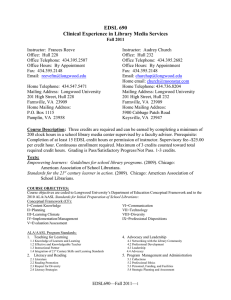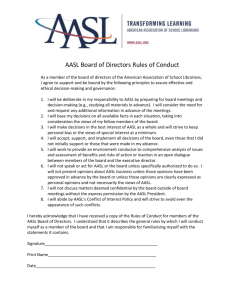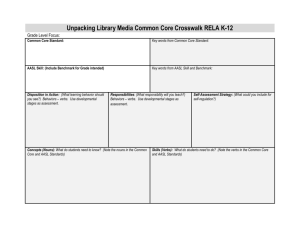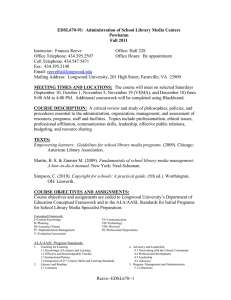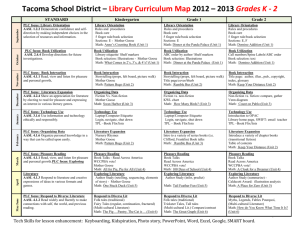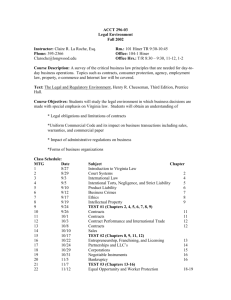EDSL 530 - Longwood University
advertisement
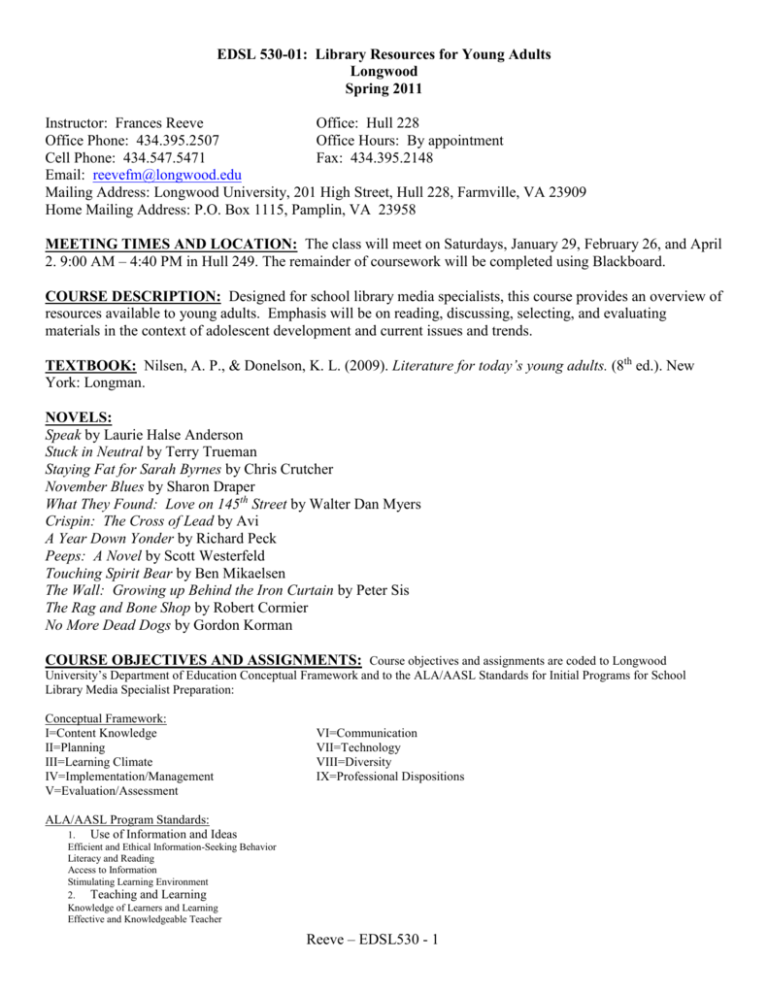
EDSL 530-01: Library Resources for Young Adults Longwood Spring 2011 Instructor: Frances Reeve Office: Hull 228 Office Phone: 434.395.2507 Office Hours: By appointment Cell Phone: 434.547.5471 Fax: 434.395.2148 Email: reevefm@longwood.edu Mailing Address: Longwood University, 201 High Street, Hull 228, Farmville, VA 23909 Home Mailing Address: P.O. Box 1115, Pamplin, VA 23958 MEETING TIMES AND LOCATION: The class will meet on Saturdays, January 29, February 26, and April 2. 9:00 AM – 4:40 PM in Hull 249. The remainder of coursework will be completed using Blackboard. COURSE DESCRIPTION: Designed for school library media specialists, this course provides an overview of resources available to young adults. Emphasis will be on reading, discussing, selecting, and evaluating materials in the context of adolescent development and current issues and trends. TEXTBOOK: Nilsen, A. P., & Donelson, K. L. (2009). Literature for today’s young adults. (8th ed.). New York: Longman. NOVELS: Speak by Laurie Halse Anderson Stuck in Neutral by Terry Trueman Staying Fat for Sarah Byrnes by Chris Crutcher November Blues by Sharon Draper What They Found: Love on 145th Street by Walter Dan Myers Crispin: The Cross of Lead by Avi A Year Down Yonder by Richard Peck Peeps: A Novel by Scott Westerfeld Touching Spirit Bear by Ben Mikaelsen The Wall: Growing up Behind the Iron Curtain by Peter Sis The Rag and Bone Shop by Robert Cormier No More Dead Dogs by Gordon Korman COURSE OBJECTIVES AND ASSIGNMENTS: Course objectives and assignments are coded to Longwood University’s Department of Education Conceptual Framework and to the ALA/AASL Standards for Initial Programs for School Library Media Specialist Preparation: Conceptual Framework: I=Content Knowledge II=Planning III=Learning Climate IV=Implementation/Management V=Evaluation/Assessment VI=Communication VII=Technology VIII=Diversity IX=Professional Dispositions ALA/AASL Program Standards: 1. Use of Information and Ideas Efficient and Ethical Information-Seeking Behavior Literacy and Reading Access to Information Stimulating Learning Environment 2. Teaching and Learning Knowledge of Learners and Learning Effective and Knowledgeable Teacher Reeve – EDSL530 - 1 Information Literacy Curriculum 3. Collaboration and Leadership Connection with the Library Community Instructional Partner Education Leader 4. Program Administration Managing Information Resources: Selecting, Organizing, Using Managing Program Resources: Human, Financial, Physical Comprehensive and Collaborative Strategic Planning and Assessment Knowledge: The student will be able to 1. describe the nature and behavior of adolescents (I; AASL 1.2) 2. trace the history and development of YA literature (I; AASL 1.2) 3. identify characteristics, representative titles, and well-known authors of YA literature (I; AASL 1.2, 4.1) Skills: The student will be able to 1. select, evaluate, and promote YA literature to adolescents (I, II, IV, VI, VII, VIII, IX; AASL 1.2, 1.4, 4.1) 2. identify a variety of techniques to encourage adolescents to become life-long readers (I, II, IV, VI, VII, IX; AASL 1.2, 1.4, 4.1) 3. identify controversies in YA literature (I, VIII, IX; AASL 1.1, 1.2,1.3, 3.3, 4.1) 4. discuss current issues related to YA literature (I, VI, VIII, IX; AASL 1.1,1.2) Attitudes: The student will be able to 1. demonstrate a personal and professional interest in reading (IX; AASL 1.1, 1.2) 2. appreciate the importance of and express a commitment to lifelong learning by reading widely and critically in the field of YA literature (IX; AASL 1.1,1.2) COURSE SCHEDULE: January 29 (Class 1) Introductions Review syllabus and assignments Discuss Blackboard Review Longwood library resources and services Electronic reserves General web pages Journal finder Off-campus access Interlibrary loan and document delivery Ask a Librarian Booktalking Videotape: Booktalking with Joni Bodart Defining YA January 30-February 7 – Definition of YA Literature Submit Textbook Assignment 1 (Nilsen, chapter 1) Discuss Speak February 8-14 - History of YA Literature Submit Textbook Assignments 2 (Nilsen, chapter 2) Discuss Stuck in Neutral Reeve – EDSL530 - 2 February 15-21 – Diversity; Realistic Fiction; Problem Novel Submit Textbook Assignment 3 (Nilsen, chapter 4) Post Diversity Article to Discussion Board Discuss Staying Fat for Sarah Byrnes February 22-28 - Evaluation of YA Literature Submit Textbook Assignment 4 (Nilsen, chapter 10; Monseau, “Seeing Ourselves in the Mirror: Students and Teachers as a Community of Readers” – on electronic reserve) Post YA Literature in the News to Discussion Board Discuss November Blues February 26 (Class 2) Present Bookalk Present Author Report March 1-7 - YA Literature in the Classroom Submit Textbook Assignment 5 (Nilsen, chapter 11; Christenbury, “Natural, Necessary, and Workable: The Connection of Young Adult Novels to the Classics” – on electronic reserve) Discuss What They Found: Love on 145th Street March 8-14 - Media Literacy Submit Textbook Assignment 6 (Nilsen, chapter 3) Discuss Crispin: The Cross of Lead Submit Urban Fiction article to Discussion board March 15-21 - Modern YA Reading Submit Textbook Assignment 7 (Nilsen, chapters 5, 6,7) Post Graphic Novel Article to Discussion Board Discuss A Year Down Yonder and Peeps: A Novel March 22-28 – Nonfiction Submit Textbook Assignment 8 (Nilsen, chapters 8,9) Discuss Touching Spirit Bear and The Wall: Growing up Behind the Iron Curtain March 29-April 4 Discuss and The Rag and Bone Shop and No More Dead Dogs April 2 (Class 3) Present Booktalk Present Thematic Bibliography Complete course evaluation April 11 Submit Exam to Assignments ASSIGNMENTS: Author Report: Choose a young adult author from the suggestion list or contact me if you want to choose an author not on the list. Post your choice in the Discussion Board. Each student should choose a different author. Prepare an author report including the following: Reeve – EDSL530 - 3 Brief biography Photograph (optional) Partial bibliography of the author’s works Significant awards List of themes or concerns commonly found in the author’s works. Quote by or about the author’s writing Good reference sources about the author Anything else you feel might be interesting to your classmates. The report must not exceed two pages. Bring copies for each member of the class and three books by your author. Be prepared to discuss your author in class. (I; AASL 1.2, 4.1) Booktalks/Book trailers: Select two books from the suggestion list or contact me if you want to choose a book not on the list. Post your choice in the Discussion Board. Each student should choose different books. Your classmates and I will evaluate your presentations. These are some suggested criteria for evaluating the booktalks/book trailers. Feel free to include others. Was the presentation creative, organized, clear, interesting? Did the presentation keep my attention? Did the presentation make me want to read the book? Why? Although you should have practiced, the performance should not be stiff or formal. Remember you are trying to interest new readers in this book. Do not give away the ending. There is no right was to do this. Be creative. Here a few starter ideas: a character monologues, a dialogue between two or more characters, question directed at the audience, pantomime, puppets, music, or newscast. Use at least one prop. Use technology for at least one of the booktalks/book trailers. You will present the booktalks/book trailers during class as if we are the students. Do not read from your notes; however, you may read excerpts from the book. Prepare a summary including the following information: Bibliographic citation of the book Major themes, ideas, and/or subject areas of the book Book discussion ideas Ways to use the book in the classroom and/or library Appropriate grades and/or ages Excerpts from reviews Awards The handout must not exceed two pages. Bring copies for each member of the class. (I, II, IV, VI; AASL 1.2, 1.4, 4.1) Journal Articles: Share three articles about young adult literature from the professional literature within the past two years. Choose an article for each of the following three topics: diversity issues (multiculturalism); graphic novels; and urban fiction (street lit or hip hop fiction). Reserve your choice by posting the title in the Discussion Board. Post a citation of your article on the Discussion Board and include a brief summary of the article and how it relates to this course. You may include URLs for electronic information. (I, VI, VIII, IX; AASL 1.1, 1.2, 1.3) Novel Discussions: Read the novels. During the appropriate week, I will post the three discussion questions for the novels in the Discussion Board. For each novel answer one question and respond to one of your classmate’s answers. Use examples from the novels because there are no wrong answers if you can support your opinion. When you respond to another posting, give substantive information. Don't simply say, "I agree." Tell why you agree. (I, VI, VIII, IX; AASL 1.2, 1.4) Textbook Assignments: Complete each of the assignments. Submit each as an attachment to the appropriate Assignment. Save either as a Word document (with a .doc extension) or as an html document (with a .htm Reeve – EDSL530 - 4 extension). Name the assignment as follows: Your Last Name—Assignment Number. For example, if I were to submit my answer to the first assignment, I would name the file: Reeve1.doc. Be sure your name is on your attachment. (I, VI, VIII, IX; AASL 1.1, 1.2, 1.3) Thematic Bibliography: Compile a bibliography of five young adult novels on a single theme or issue. Examples include divorce, teen pregnancy, a specific historical period, or a specific cultural group. You are not required to read these books. For each title include Complete bibliographic citation Brief annotation (not more than two sentences) Significant awards or honors At least one review from a reliable source (Include the citation for the review.) Based on the information you have gathered, would you suggest this book be purchased for an age appropriate collection? Why or why not? Bring copies of the bibliography for each member of the class and be prepared to discuss your selections. (I, II, IV, VI, VII; AASL 1.2, 4.1) YA Literature in the News: Share one item from the popular news media concerning current young adult literature. These articles may be in any format (newspapers, magazines, TV, Internet, etc.). Chose items from sources that the general public would read; do not choose items from professional literature such as School Library Journal or from a listserv designed for school library media specialists. Post a citation of your article on the Discussion Board and include a brief summary of the article and how it relates to this course. You may include URLs for electronic information. (I, VI, VIII, IX; AASL 1.1, 1.2) GRADING POLICY: Assignments should be submitted on or before their due date. Credit may be deducted for unexcused late submissions. The following grading scale will be used: A 94-100 B 86-93 C 78-85 Grades for the course will be determined as follows: Attendance and Class Participation 12 Author Report 3 Booktalks/Book Trailers 16 Journal Articles 6 Novel Discussions 36 Textbook Assignments 16 Thematic Bibliography 3 YA Literature in the News 2 Exam 6 Total 100 ACCOMMODATIONS: Any student who feels s/he may need an accommodation based on the impact of a physical, psychological, medical, or learning disability should contact the Office for Disability Services (109 Graham Building, 434-395-2391) to register for services. ATTENDANCE POLICY: Each student is expected to attend all on-site classes. Students must assume full responsibility for any work missed due to an absence. All absences must be explained. EVALUATION OF THE INSTRUCTOR: Each student will have an opportunity to evaluate the instructor at the conclusion of the course. Reeve – EDSL530 - 5 HONOR CODE: Each student is expected to follow Longwood University policy for the Honor Code as stated in the latest edition of the Longwood University Graduate Catalog, available online at http://www.longwood.edu/graduatestudies/. TECHNICAL ASSISTANCE: Longwood provides a toll-free number (877-267-7883) for distance education students. You can reach User Support Services, the Library Reference Desk, and the Graduate Studies Office. Check the various Web pages for working hours of each department. After working hours you can leave a message for the Library and Graduate Studies. You can email User Support Services at helpdesk@longwood.edu to get a response on the next working day. ADMISSION TO THE GRADUATE OR LICENSURE PROGRAMS: Prospective applicants are allowed to enroll in up to nine credit hours (3 courses) prior to being admitted to a degree or licensure only program and have those hours apply to the admitted program. Students should submit an Application for Graduate Admission promptly to avoid having course work in excess of the six credit hours not apply once admitted. Application materials are available by contacting the Office of Graduate Studies (434-395-2707 or graduate@longwood.edu) or on our web site at http://www.longwood.edu/graduatestudies/application.shtml RESOURCES: Additional materials are listed in Blackboard under Resources. Databases: All of these databases are available from the Longwood Library. Book Review Index Online (1965-present) - Provides citations to book reviews of over 2.5 million popular, academic and professional titles Children’s Literature Comprehensive Database (Current) - Contains records, full-text reviews and book jacket images of children’s books, searchable by age group, genre, and keyword Graphic Novels Core Collection (current) – Contains annotations, cover art, review excerpts, and grade levels for over 2,000 fiction and nonfiction graphic novels Horn Book Guide Online (1989-present) - Contains over 60,000 book reviews of fiction and non-fiction published in the United States for young people, by author, illustrator, title, subject, and rating from the original Horn Book review Library Literature (1984-present) - Indexes articles and book reviews in key library and information science periodicals as well as books, chapters in collected works such as conference proceedings, library school theses and pamphlets Library, Information Science & Technology Abstracts (1960s-present) - Indexes and abstracts over 600 periodicals as well as books and research related to librarianship, online information retrieval, information management and more Literary Index (Current - Indexes articles in all of the Gale literature series, searchable by author or title of a literary work Literature Resource Center (Coverage varies) - Contains full text articles, critical essays and author biographies from all volumes of Contemporary Authors and the Dictionary of Literary Biography, and from selected volumes in the Gale literary criticism series Middle and Junior High Core Collection (1999-present) - Contains selective annotated list of fiction and nonfiction books for your adults in grades five through nine, along with review sources and other professional aids for librarians and school media specialists Senior High Core Collection (1999-present) - Contains selective annotated list of fiction and nonfiction books for young adults in grades nine through twelve along with review sources and other professional aids for librarians and school media specialists Wilson OmniFile Full Text Select (1994-present) - Provides full text, indexing and abstracts for 1,340 multidisciplinary magazines and journals. Reeve – EDSL530 - 6 Books: Gorman, M. (2003). Getting graphic!: Using graphic novels to promote literacy with preteens and teens. Worthington, Ohio: Linworth. Herz, Sarah K. (2005). From Hinton to Hamlet: Building bridges between young adult literature and the classics. (2nd ed.). Westport, Conn.: Greenwood Press. Krashen, S. D. (2004). The power of reading: Insights from the research. (2nd ed.). Englewood, Colo.: Libraries Unlimited. Lyga, A. A. W. (2004). Graphic novels in your media center: A definitive guide. Westport, Conn.: Libraries Unlimited. Monseau, V. R., & Salvner, G. M. (Eds.) (2000). Reading their world: The young adult novel in the classroom. (2nd ed.). Portsmouth, NH: Boynton/Cook. Journals: All of these journals are available in print form. Information on the Websites listed below varies from subscription information to tables of contents to selected articles to full text. This list is given primarily for subscription information and journal browsing. To locate specific articles in these journals, use the Databases link from the Longwood Library Web page at http://www.longwood.edu/library/index.htm. American Libraries Booklist Knowledge Quest Library Journal Library Media Connection School Library Journal Teacher Librarian http://www.ala.org/alonline/index.html http://www.ala.org/booklist/ http://www.ala.org/aasl/kqweb/index.html http://www.libraryjournal.com/ http://www.linworth.com/lmc/ http://www.schoollibraryjournal.com/ http://www.teacherlibrarian.com/ Reeve – EDSL530 - 7
